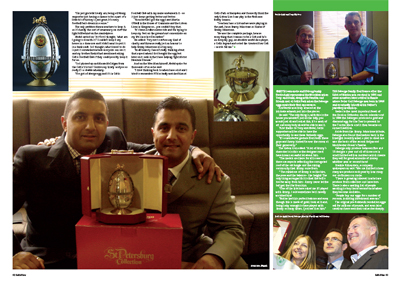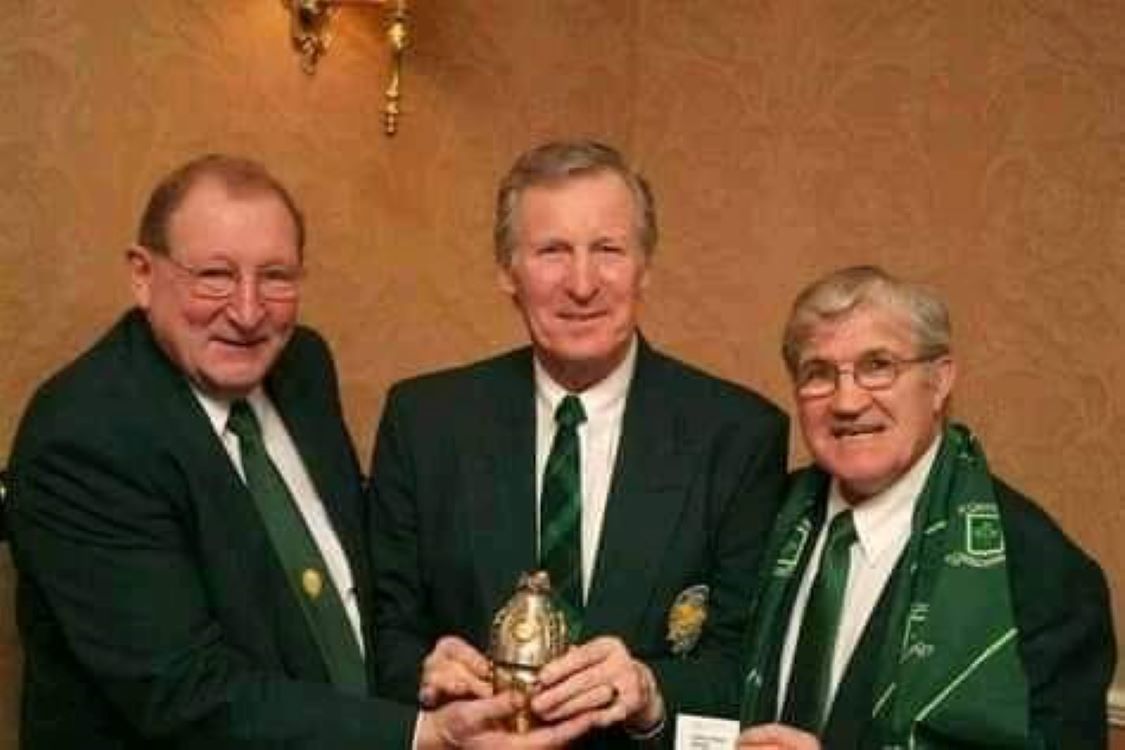Player Homepage | Player Pictures
The Honour of the Faberge Egg
 A Fabergé egg is a jeweled egg made by the House of Fabergé from 1885 to 1917. Most were miniature eggs that were popular gifts at Easter, and were very expensive and ornate products passed between Royalty, in particular in the old Russia prior to the Bolshevik Revolution).
A Fabergé egg is a jeweled egg made by the House of Fabergé from 1885 to 1917. Most were miniature eggs that were popular gifts at Easter, and were very expensive and ornate products passed between Royalty, in particular in the old Russia prior to the Bolshevik Revolution).
In 2005, family descendant Sarah Faberge created a limited number of new eggs in aid of former Celtic football player Jimmy Johnstone, who was suffering from motor neurone disease.
“I am not a big football fan, but wanted to do something to help. He was inspirational as a footballer and now he is inspiring people as he battles his illness. People admire him for different reasons now.”
Jinky was immortalised in 19 eggs priced at £10,000 each, with Jinky getting the proceeds of the sales . All the eggs were snapped up.
The Jimmy Johnstone eggs are made from silver, enamel, yellow and black gold and feature the medals of the footballer’s major achievements, the UEFA European Cup, the Scottish league championship, the Scottish Cup and Scottish League Cup. Permission was given by the organisers of these competitions to strike the new medals from the original dies.







Lisbon Lion still fires imagination
Hugh McIlvanney (Sunday Times)
05 June 2005 With the desperate fight against motor neurone disease remorselessly reducing his mobility, Jimmy Johnstone won’t be able to travel down from the west of Scotland on Tuesday for a little ceremony in his honour at the House of Commons.
But he will be a lively presence in the minds of the gathering, for Johnstone is one of those rare footballers who brighten indelibly the memories of everybody who witnessed them at work.
Of all the boys of winter who have lifted my spirits over many decades, none has left more vivid images than the wee man, and not just because he was the most magically intricate dribbler I ever saw.
It was his capacity to express effervescent, outrageous, almost surreal mischief through his play — and to make all of his darting runs and surges of convoluted trickery a deadly weapon for his team — that rendered him unforgettable. That and the ability not only to thrill but, with his antics on the field, to evoke smiles and sometimes laughter.
At the Commons, there is to be an unveiling of an egg, but no ordinary egg. It is the first of a series of 19 that will be created by Sarah Fabergé, great-granddaughter of Carl Fabergé, the Russian royal court jeweller. The total of 19 corresponds with the number of major winner’s medals amassed by Johnstone (including his precious souvenir from 1967, when Celtic’s Lisbon Lions became the first British team to capture the European Cup).
From the sale of the eggs, he will be helped financially in the battle with his affliction. Sarah Fabergé was moved by the bravery of that struggle and says he is the first living person since the Czars and Czarinas to have a Fabergé egg designed in his honour. Watching him as a player on film, she was entranced by the wonders he performed. That puts the lady in a rather substantial throng.
Fabergé eggs to fete Celtic hero
Ewing Grahame (Sunday Times)19 December 2004 A CELTIC football legend is to be immortalised in a range of diamond-studded Fabergé eggs created by descendants of the Tsar’s court jewellers. Jimmy Johnstone joins Thomas Jefferson and Lord Nelson in a select group of people who have inspired the creation of one of the glittering and precious objects.
Johnstone’s battle against motor neurone disease inspired the honour.
The most expensive egg in the range will cost £10,000. Made from platinum and gold, it will depict Johnstone kicking a diamond football. There will be a limited edition of nineteen hand-crafted pieces, to mark the major honours Johnstone helped Celtic win from 1966 to 1974. These will be completed before the end of the football season and will be unveiled at dinners in Britain.
Another 44 eggs made of gold, crystal and enamel will celebrate 1944, the year of Johnstone’s birth. These will each sell for about £4,000.
Johnstone, voted the greatest-ever Celtic player by supporters in 2002, contracted motor neurone disease three years ago and has lost the use of his hands and arms.
Motor neurone disease affects the nerve cells in the brain and spinal cord along which the brain sends instructions in the form of electrical impulses to the muscles. Its cause is not known.
Degeneration of the nerve cells leads to weakness and wasting of muscles. This generally occurs in arms or legs but can affect muscles in the face and throat, causing problems with speech.
The Fabergé family’s involvement is the result of a coincidence involving Sarah Fabergé, great grand-daughter of the jeweller Peter Carl Fabergé.
Jeff Healey, who produced the documentary film about Johnstone’s life, Lord of the Wing, said a friend of Sarah Fabergé attended the film’s London premiere earlier this year — and was so moved by it that she asked for a copy of the DVD.
“She then lent her copy to Sarah and it had a similar effect on her,” said Healey. “Sarah then contacted me and said she would like to create something special for Jinky to help raise funds for him.”
Johnstone, speaking from his home in Lanarkshire, said he had never expected to be associated with such an illustrious name in such a specialised business. “It’s a great honour, not just for me but for Scotland and also for football,” he said.
Three collectors have already agreed to buy the most expensive eggs and one has chosen to give his to Celtic so that supporters who tour the club’s stadium can view it.
Johnstone will receive about half the money raised from the sale of the exquisite eggs.
Peter Carl Fabergé was the Russian court jeweller from 1885. Easter was the most important feast in the Orthodox church calendar and Alexander III asked him to create a surprise gift for his wife, Maria Feodorovna.
The jewelled egg he delivered was so well received that one was commissioned each year. Members of the Fabergé family have lived in England since 1906 and remaining members fled from Russia after the Bolshevik revolution in 1917.
The family business continues and last year Theo Faberge, Carl’s grandson and the father of Sarah, presented the city of St Petersburg with an egg to commemorate its 300th anniversary. He had spent 1,000 hours painstakingly working on it.
Faberge’s ingenious use of enamelling on gold and silver, his stone cutting and use of precious gems, made his imperial Easter eggs works of art.
Like the Imperial eggs created for the Romanovs, Johnstone’s eggs will also include surprise gifts and ornaments.
Johnstone, who was born in 1944 in Glasgow, has a celebrity following which earlier this year led to Johnny Depp, Shane MacGowan, of the Pogues, and Jim Kerr, of Simple Minds, collaborating on a charity single to raise funds for motor neurone disease. The idea for the single came after Kerr and Johnstone performed a version of Dirty Old Town during shooting for the film of Johnstone’s life.
Faberge descendants keep up tradition
By Bill Wilson
BBC News business reporter
9 June 2005
The Faberge family’s jewellery-making firm, which made its name by crafting gold and diamond eggs for the Russian tsars, has found itself back in the news recently.
Not only was a plot to steal one of the famous eggs at the centre of recent Hollywood film Ocean’s Twelve, but a new UK item has also attracted attention.
Family descendant Sarah Faberge has created a limited number of new eggs in aid of former Celtic football player Jimmy Johnstone, who is suffering from motor neurone disease.
“I am not a big football fan, but wanted to do something to help,” Ms Faberge told BBC News. “He was inspirational as a footballer and now he is inspiring people as he battles his illness. People admire him for different reasons now.”
The ex-Scottish international winger is being immortalised in 19 eggs priced at £10,000 each, with Mr Johnstone getting the proceeds of the sales. All the eggs have been snapped up.
Limited editions are central to the family firm’s philosophy. They produce between five and 15 designs a year, each in small numbers.
“We are limited in how many we produce each year by how many our craftsmen can make,” says company spokesman Frankie Birkenstein.
The 500 St Vladimir eggs created in 1988 to commemorate 1000 years of the Russian orthodox church
The Russian orthodox church eggs have risen sharply in value
A consequence of the limited runs, whether intentional or not, is that the eggs fetch a great deal of money, both when new and in the second-hand market.
“There is growing interest in what we produce from collectors and investors. There is also a waiting list of people wanting to buy items second-hand when they become available,” says Ms Birkenstein.
“People buy our eggs for a number of reasons, including investment reasons.”
The original pre-Bolshevik revolution eggs sell for millions of pounds, and even later creations have seen their value rise sharply.
The 500 St Vladimir eggs created in 1988 to commemorate 1000 years of the Russian orthodox church cost £1,500 at the time. They are now selling for £12,000.
And this is a market where investors can enter at relatively low levels. Most of what the jeweller makes cost between £2,000 and £10,000, though some items can be had for just £350, while commissioned pieces can cost up to £1m.
There have been a number of different enamel, diamond, gold and silver eggs, from the centenary of the Olympics to the 200th anniversary of the White House.
Legal history
But take note; although they are made by members of the Faberge family, these are not, strictly speaking, Faberge eggs.
The eggs currently produced are part of the St Petersburg Collection, which Theo Faberge set up with his daughter Sarah as recently as 1985, four years after his engineering firm accepted its first egg commission.
The creation of the collection marked the revival of the business once run by Theo Faberge’s grandfather, Carl Faberge, who left the country in 1917 when its Russian parent company was taken over by a revolutionary committee.
During the upheaval that followed, the name Faberge Inc was registered in the US in the 1930s by a firm making toiletries, and has since been acquired by Unilever.
Legal action by Faberge family members to regain the rights to use the name for commercial purposes has failed.
The Jimmy Johnstone eggs are made from silver, enamel, yellow and black gold and feature the medals of the footballer’s major achievements, the UEFA European Cup, the Scottish league championship, the Scottish Cup and Scottish League Cup. Permission was given by the organisers of these competitions to strike the new medals from the original dies.



